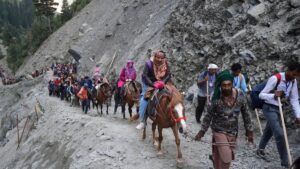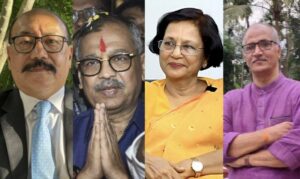Table of Contents
On November 8, 2024, Bengaluru achieved a significant milestone by unveiling its first digital population clock at the Institute for Social and Economic Change (ISEC). This innovative project, a collaboration between ISEC and the Union Ministry of Health and Family Welfare (MoHFW), aims to track real-time population estimates for both Karnataka and India. As the world faces growing concerns about rapid population growth, sustainable development, and the challenges posed by demographic shifts, Bengaluru’s digital population clock serves as a critical tool for raising public awareness and providing vital data for research and policy formulation.
This article explores the features, objectives, and significance of Bengaluru’s digital population clock in the context of demographic research and sustainable development, making it a valuable resource for aspirants preparing for the UPSC Civil Services Examination.
Key Features of Bengaluru’s Digital Population Clock
Strategic Placement
The digital population clock is prominently installed at the entrance of ISEC, making it easily accessible to the public, researchers, and policymakers. Its strategic location serves as a visual reminder of the urgent need for addressing population growth and its impact on societal, environmental, and economic factors.
Real-Time Updates
The clock provides continuous updates on the population estimates of Karnataka and India:
- Karnataka’s Population: Updates every 1 minute and 10 seconds.
- India’s Population: Updates every 2 seconds.
This precision allows for a constantly evolving understanding of demographic dynamics, offering a more accurate representation of the country and state’s population growth patterns than traditional static data.
Demographic Data Calculation
In addition to simply tracking the population, the clock takes into account various demographic indicators that affect population growth, such as:
- Birth Rates
- Death Rates
- Migration Patterns
- Life Expectancy
- Fertility Rates
- Mortality Rates
These calculations help in understanding not just the quantity of population growth but also the qualitative factors that influence the demographic structure of the region.
Global vs. National Focus
Unlike global population clocks that track worldwide population trends, Bengaluru’s digital population clock focuses specifically on the population of Karnataka and India. This localized approach makes it more relevant for regional planning and development initiatives, providing a unique perspective on national and state-level demographic changes.
Objectives of the Digital Population Clock
Raising Public Awareness
One of the primary objectives of the digital population clock is to raise awareness about the rapid pace of population growth and its implications for sustainable development. With the population growing exponentially, the clock serves as a daily reminder of the challenges posed by overpopulation, such as increased resource demand, environmental degradation, and pressure on public services like healthcare and education.
By presenting real-time data, the clock aims to engage citizens in discussions about family planning, sustainable practices, and the importance of demographic policies.
Supporting Research and Policy Formulation
The clock is not just a tool for public awareness; it also provides invaluable data for researchers, policymakers, and institutions. The real-time data helps in the assessment of population trends, enabling researchers to study the effects of demographic changes on health, infrastructure, and the economy. Policymakers can use this data to formulate evidence-based policies that address the challenges posed by demographic shifts and ensure that resources are distributed equitably.
Census Data Research Workstation at ISEC
In addition to the digital population clock, ISEC has established a Census Data Research Workstation, supported by MoHFW, which provides researchers with access to comprehensive census data. This facility is equipped with advanced software and analytical tools that allow for detailed examinations of population trends. It facilitates rigorous studies on topics such as:
- Population Growth Patterns
- Migration Dynamics
- Fertility and Mortality Rates
- Urbanization and its Impact
The Census Data Research Workstation plays a crucial role in enabling in-depth research, offering resources to students, scholars, and government bodies to aid in policy planning, development, and implementation.
Collaboration: ISEC and the MoHFW
The digital population clock is part of a national initiative launched by MoHFW, aimed at installing similar population clocks at 18 Population Research Centres (PRCs) across India. The collaboration between ISEC and MoHFW is a crucial step toward enhancing the capacity for demographic research in India.
Objectives of PRCs:
- Conduct research on family planning, population control, and health dynamics.
- Analyze fertility and mortality trends.
- Evaluate family planning program effectiveness and propose improvements.
- Provide evidence-based recommendations for policymakers to address demographic challenges.
PRCs play a critical role in shaping family welfare and health policies by providing valuable data and research that inform national and regional interventions.
Significance of Bengaluru’s Digital Population Clock
- Promoting Sustainable Development
By highlighting the rapid pace of population growth, the digital population clock serves as a tool for public education on the need for sustainable development practices. It emphasizes the importance of controlling population growth to ensure that future generations have access to the resources they need for a high quality of life. - Facilitating Policy and Planning
Accurate, real-time demographic data is essential for effective policy-making and planning. With the clock providing continuous updates on population changes, government authorities can make informed decisions on resource allocation, urban planning, healthcare, and education. - Supporting Academic Research
The integration of the Census Data Research Workstation with the digital population clock creates a hub for demographic research. This setup will provide valuable insights into India’s evolving population landscape, empowering scholars and researchers to conduct studies that support evidence-based policy making. - Enhancing Public Engagement
The visual nature of the population clock engages citizens in discussions about population dynamics and their consequences. It is a tool for fostering dialogue on critical issues like urbanization, resource distribution, and public health, thereby contributing to a more informed and active citizenry.
Conclusion
Bengaluru’s first digital population clock is a pioneering initiative that brings real-time population tracking to the forefront of public awareness and research. It underscores the critical need for sustainable development and data-driven decision-making in an era of rapid population growth. With its focus on Karnataka and India, the clock provides a localized view of demographic trends, offering policymakers and researchers valuable insights to address the challenges of an ever-growing population.


 Operation Shiva 2025: Indian Army’s Ma...
Operation Shiva 2025: Indian Army’s Ma...
 World Youth Skills Day 2025, Theme, Hist...
World Youth Skills Day 2025, Theme, Hist...
 President Murmu Nominates Four Members t...
President Murmu Nominates Four Members t...





















